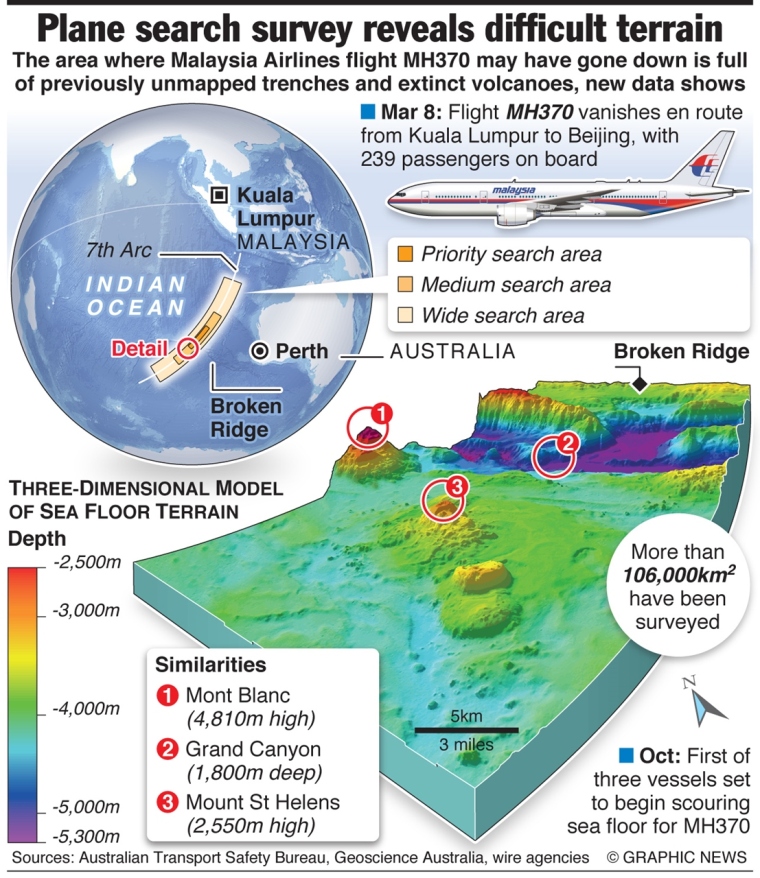Malaysia Flight MH 370 Latest Search News Update: Amazing Underwater World Found By Scientists
In scouring the bottom of the ocean where Malaysia Airlines Flight MH370 might have settled down, Australian authorities have found instead an amazing underwater world even as they continue the search for the still missing aircraft.
Using high-tech sonar equipment, search crews combing large portions of the Indian Ocean off the coast of Australia uncovered maps of the ocean floor more detailed than anything available before.

The three-dimensional color images produced in the study showed undersea mountains with some peaks more than three kilometers high as well as a trench deeper than the Grand Canyon. Also found was an underwater volcano bigger than Mount St. Helens.
"The recently acquired high-resolution bathymetry data has revealed many of these seabed features for the first time," said the Australian Transport Safety Bureau, which is leading the search for the missing aircraft.
The researchers were dumbfounded at the unbelievable sights they found in the search area known as Broken Ridge around 1,770 km off the west coast of the Australian city of Perth. The area once formed the margin between two geological plates that separated between 20 and 100 million years ago, scientists said.
"The terrain of the area around Broken Ridge makes the European Alps look like foothills," said Dr. Simon Boxall, a lecturer in ocean and earth science at the University of Southampton. "If you stood in the valley you would have, towering above you, mountains that were about 3 kilometers high – just coming straight up in front of you."
The experts used sound pulses that are bounced off the sea bed to unravel his previously uncharted world.
The researchers' exultation at the new find was tempered, however, by the ever-increasing possibility that the missing plane will never be found.
The flight vanished without a trace on March 8 during a trip from Kuala Lumpur to Beijing with 239 people on board. It mysteriously changed course and headed south.
Despite a massive search operation, which involved 26 countries, stretching from the Gulf of Thailand to the Bay of Bengal and, finally, the Indian Ocean, no trace of the plane has been found.
It's unlikely the plane will ever be found, Boxall said.
While the families of the passengers on board MH370 hope the searches will provide answers, Boxall said he believed the chances of finding MH370 are still "very slim," despite the improved mapping.
"The ocean is so vast, it is almost an impossible task," he said.
But despite the tall odds, the authorities continue to nurse hopes that they could eventually stumble on the remains of the missing flight. This month, two ships equipped with high-tech equipment – the Fugro Discovery and Malaysian-contracted GO Phoenix – will plunge deep beneath the ocean surface to map more of the floor using sound waves.
The ships will scan 16,000 feet of the section in "the 7th arc" where the Boeing 777 is believed to crashed after running out of fuel.
The location was pinpointed based on the jet's final satellite communication and the projected descent. The particular area is several hundred miles off Western Australia.
Experts believe the aircraft ran out of fuel in this area, which is around 60,000 square kilometres. An international fleet of ships and aircraft conducted surface search operations in the area for six weeks, between March 18 and April 28, but found no debris.
 Christians don't have to affirm transgenderism, but they can’t express that view at work: tribunal
Christians don't have to affirm transgenderism, but they can’t express that view at work: tribunal Archaeology discovery: Medieval Christian prayer beads found on Holy Island
Archaeology discovery: Medieval Christian prayer beads found on Holy Island Presbyterian Church in America votes to leave National Association of Evangelicals
Presbyterian Church in America votes to leave National Association of Evangelicals Over 50 killed in 'vile and satanic' attack at Nigerian church on Pentecost Sunday
Over 50 killed in 'vile and satanic' attack at Nigerian church on Pentecost Sunday Ukrainian Orthodox Church severs ties with Moscow over Patriarch Kirill's support for Putin's war
Ukrainian Orthodox Church severs ties with Moscow over Patriarch Kirill's support for Putin's war Islamic State kills 20 Nigerian Christians as revenge for US airstrike
Islamic State kills 20 Nigerian Christians as revenge for US airstrike Man who served 33 years in prison for murder leads inmates to Christ
Man who served 33 years in prison for murder leads inmates to Christ


 Nigerian student beaten to death, body burned over ‘blasphemous’ WhatsApp message
Nigerian student beaten to death, body burned over ‘blasphemous’ WhatsApp message 'A new low': World reacts after Hong Kong arrests 90-year-old Cardinal Joseph Zen
'A new low': World reacts after Hong Kong arrests 90-year-old Cardinal Joseph Zen Iran sentences Christian man to 10 years in prison for hosting house church worship gathering
Iran sentences Christian man to 10 years in prison for hosting house church worship gathering French Guyana: Pastor shot dead, church set on fire after meeting delegation of Evangelicals
French Guyana: Pastor shot dead, church set on fire after meeting delegation of Evangelicals ‘Talking Jesus’ report finds only 6% of UK adults identify as practicing Christians
‘Talking Jesus’ report finds only 6% of UK adults identify as practicing Christians Mission Eurasia ministry center blown up in Ukraine, hundreds of Bibles destroyed: 'God will provide'
Mission Eurasia ministry center blown up in Ukraine, hundreds of Bibles destroyed: 'God will provide' Church holds service for first time after ISIS desecrated it 8 years ago
Church holds service for first time after ISIS desecrated it 8 years ago Burger King apologizes for 'offensive campaign' using Jesus' words at the Last Supper
Burger King apologizes for 'offensive campaign' using Jesus' words at the Last Supper Uganda: Muslims abduct teacher, burn him inside mosque for praying in Christ’s name
Uganda: Muslims abduct teacher, burn him inside mosque for praying in Christ’s name